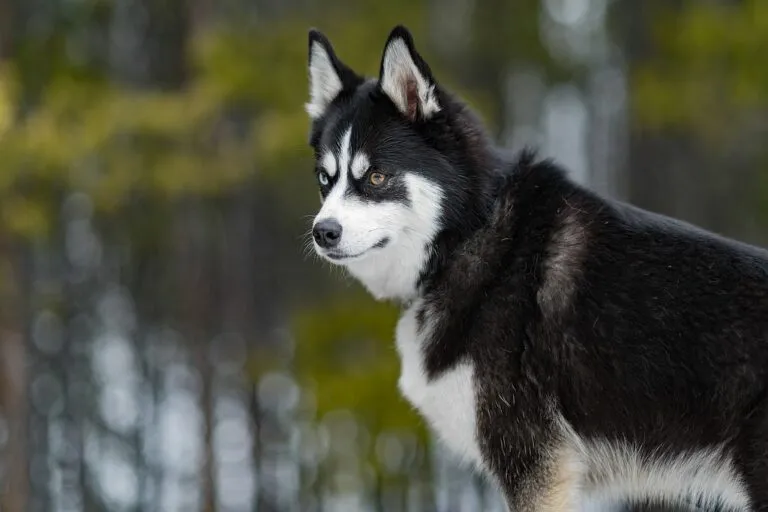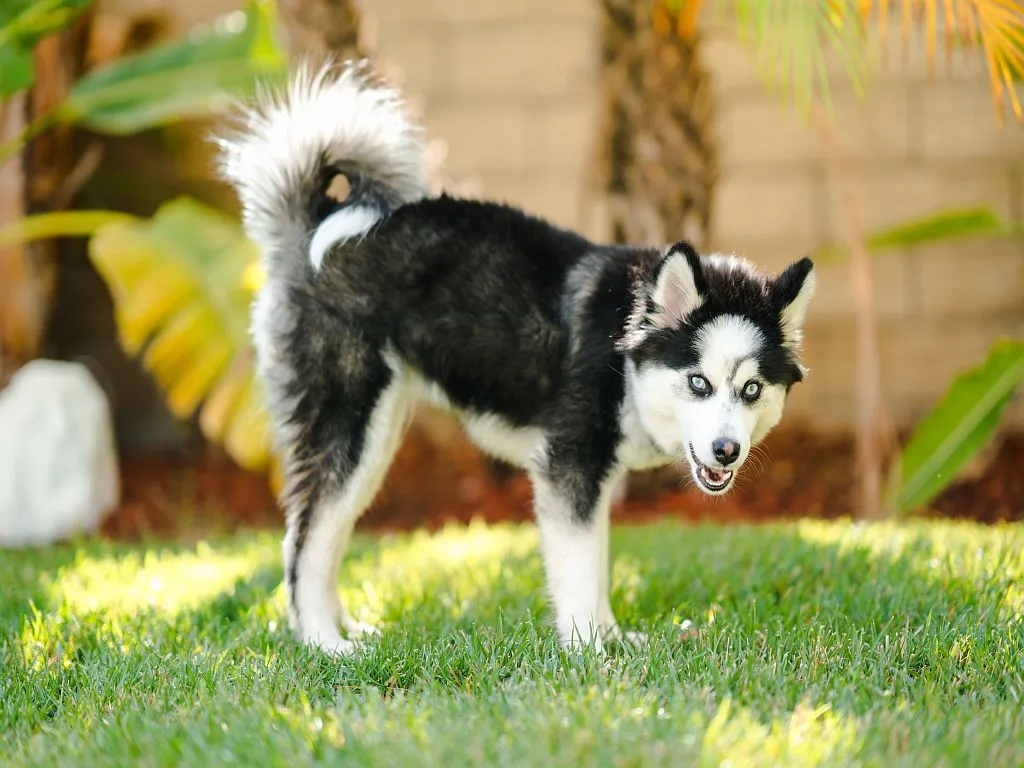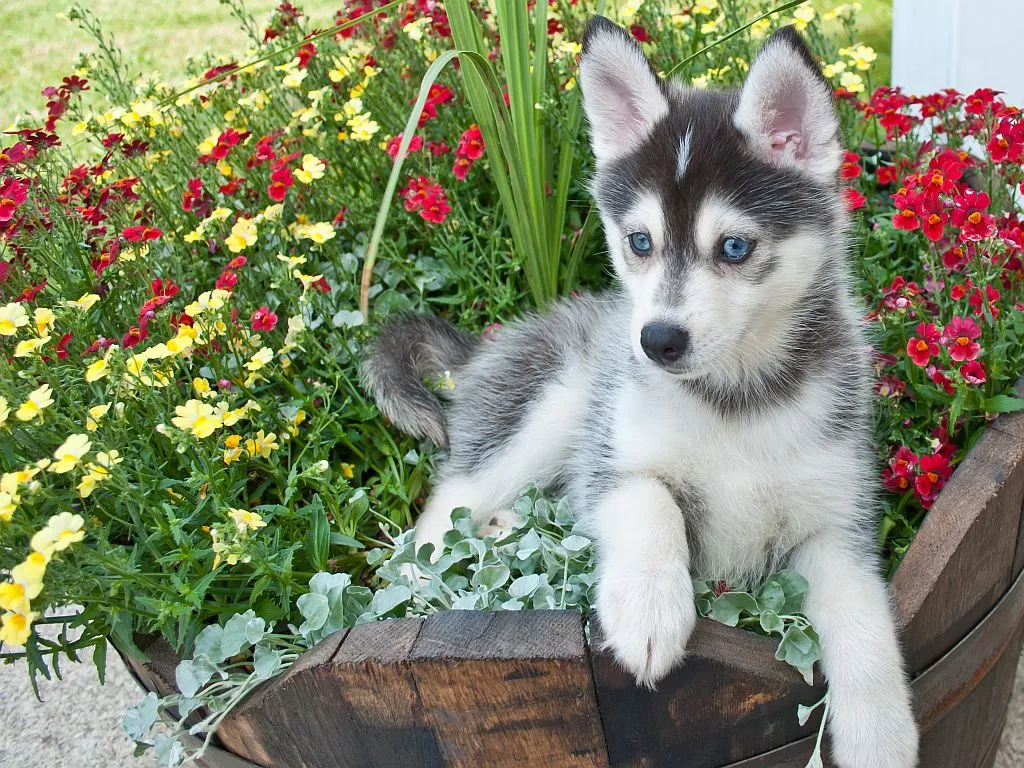Medium Size Poodle
A Pomsky is an almost irresistible mix of two breeds: it is a combination of the Pomeranian with the Siberian Husky. The aim of this hybrid breed is to bring together the beauty of the Husky with the affectionate character and small size of the Pomeranian. But just like all "designer dogs", the Pomsky often brings many surprises.

© camerasandcanines / stock.adobe.com
The Pomsky is a mixed-breed dog with a character full of surprises.
Ideally, a Pomsky looks like a long-haired Husky in a mini format. Particularly, the puppies stand out with this look. However, with mixed breeds, it’s unpredictable which traits of the parent breeds will dominate. Thus, adult Pomskies can vary significantly – there is no standard.
These dogs often have a shoulder height of around 30cm, though this can vary greatly. Husky males can reach up to 60cm in height, whereas Pomeranians are around 20cm small. So, there are small or medium-sized Pomsky dogs. Weight can range from 4 to 14 kilograms. The fur is very dense and of varying lengths and can be white, brown, black or grey. Especially popular are the bright blue eyes of the Husky combined with the curled tail of the Pomeranian.
 © Jonathan / stock.adobe.com
© Jonathan / stock.adobe.com
While the Pomeranian bonds closely with its caregiver, this is not necessarily the case with a Husky. Sled dogs are used to working with various people. It is uncertain what traits a Pomsky will have. It’s also unclear to what extent a Pomsky will inherit the hunting instinct and need for freedom from its northern ancestors. Fans describe Pomskies as adaptable and people-oriented. Yet mixing two breeds doesn’t automatically result in the best of both. A Pomsky is often a surprise package. Generally, they are friendly towards other dogs; both the Siberian Husky and the Pomeranian appreciate canine company. They can be prone to barking and hunting, and are usually sceptical around small children. Consider enroling your Pomsky puppy in a puppy school to promote socialisation.
Pomeranians enjoy playing with their owner, while Huskies prefer their own activities. If you train your Pomsky from a young age, it might enjoy playing with you in the long run. Try to find an activity both of you enjoy, such as agility for small dogs or teaching tricks. However, the independent nature of the Husky might mean your dog only participates when it feels like it. You can delight your Pomsky with outdoor activities and intelligence toys. Adult and medium-sized dogs, after appropriate training, can accompany you on light jogging sessions. Ensure not to overwork your Pomsky, so that it continues to enjoy the activities.
Firstly, nature doesn’t usually permit a “Pomsky”. Even the Pomeranian alone is challenging to breed and considered not robust. Additionally, the size differences between the breeds are so significant that mating rarely works naturally. Pomskies are therefore the result of artificial insemination. Breeders use the semen of a Pomeranian, with the mother always being a Siberian Husky. Otherwise, a Pomeranian would have to carry puppies too large for its small body.
Both parent breeds are predisposed to eye diseases. Allergies and fur issues can also occur frequently. Only Siberian Huskies with healthy hips should be used for breeding. Both parents should be tested for patella luxation to exclude this joint disease in the offspring. Neither the Husky nor the Pomeranian enjoys summer heat. The thick fur of a Pomsky retains a lot of warmth. Schedule outings in the cool morning or evening hours during summer and ensure your dog has a shady spot. These dogs are not suitable for living in hot countries or overheated attic flats. With good care, these dogs can live up to 14 years.
Whether small or large, every dog appreciates a meat-rich meal in its bowl. Such a diet also benefits its health. Ensure that meat is the first ingredient listed in the food, whether you are feeding wet or dry food. Puppies of small breeds – which likely includes a young Pomsky – require puppy food with small kibbles. Later, you should also pay attention to the size of the kibbles in the dry food.
Stick to the feeding recommendations of the manufacturer and factor in treats to the daily amount. Especially if you train a lot with your dog and use food as motivation, it is advisable to use dry food kibbles as rewards. This way, your dog earns its food without consuming too many extra calories. For treats, small bones made of beef rawhide or dried tripe pieces are good options, but only under supervision. Ensure your Pomsky always has access to fresh drinking water. In summer, carry a water bottle with a travel bowl for your dog during long outings.
Even though a Pomsky is small, it has a lot of fur. It combines the dense coat of a northern dog with the luxurious hair of a Pomeranian. The dogs can shed heavily, especially during coat change. Owners should comb their dog thoroughly at least every other day. Pomskies usually shed more during warmer months. Fans recommend brushing twice daily during this period to prevent a house full of dog hair.
Bathe the dog only when it is very dirty. Usually, it is enough to brush out dried dirt. If your dog does need a bath, use a mild dog shampoo to avoid irritating the skin. Trim the claws with a claw cutter when they start making noise on the floor. If you are unsure, your vet can help with the pedicure.
 © jstaley4011 / stock.adobe.com
© jstaley4011 / stock.adobe.com
“Sled dog or lap dog” – it’s hard to predict what a Pomsky will become. Potential owners should enjoy being outdoors and be willing to engage in various activities with their dog. Despite their small size, Pomskies are not best suited for urban living due to their Husky heritage. They are certainly not lap dogs.
Ideally, you should have some dog experience to handle a mix of Husky and Pomeranian characteristics. A house with a garden is perfect. But be careful: leave a Pomsky alone in the garden, and it might start barking at passers-by. Huskies are escape artists, so ensure your garden is secure. If bringing a Pomsky into a family, children should be at least of primary school age, as many Pomskies are sceptical of young children. If introduced to cats as puppies, Pomskies usually get along fine. However, they might pose a risk to small rodents due to their hunting instincts.
Think carefully about the breed characteristics of both the Husky and Pomeranian before acquiring a Pomsky based solely on looks. Ensure you’re prepared for the grooming and care they require.
The Pomsky belongs to the so-called “designer dogs”, which are deliberate crossbreeds of two breeds. Therefore, you cannot purchase one from a breeder associated with an FCI-affiliated kennel club. Many designer dog breeders take advantage of the current trend for hybrid dogs, selling them without club affiliation, health, and temperament tests, often for high prices.
Before opting for a designer dog, we recommend looking at recognised breeds. For example, the medium or small Spitz is an excellent alternative for those charmed by the Pomeranian but wanting a slightly larger dog. The Norwegian Lundehund and the Shiba Inu are also similar in size to the Siberian Husky and Pomeranian and share the charming nature of their original breeds.
If you decide on a Pomsky, ensure breeders use parent animals with pedigrees and have passed necessary health tests for their breed. Visit the puppies in their home environment and check out the parents and surroundings. Early socialisation and imprinting are crucial for the dog’s life. Never buy dogs from dubious sources, such as those sold from a car boot.
Those seeking an adult Pomsky can look in shelters for mixed breeds. While it’s unlikely to find a Pomeranian-Husky mix in a nearby shelter, it’s not impossible. More commonly, you’ll find other sled dog or Spitz mixes that can be just as charming as the designer dog varieties.
Whether you choose a designer dog, a mix from a shelter, or a Spitz from recognised breeding, we wish you great delight with your canine companion!
If you are interested in the Pomsky, you might also like these breeds:
Fans of the Bearded Collie agree that those who aren't familiar with this dog breed simply have to get acquainted with it. And those who have experienced how a Bearded Collie bolts across meadows with its flowing fur, how it rolls around full of energy and joy and how it attentively and observantly takes into account its owners wishes become simply addicted to this original dog breed and its unique charm.
The Goldendoodle isn't a breed, but a pairing between Golden Retrievers and Medium or Standard Poodles. Marketed as a low-maintenance dog for allergy sufferers, this hybrid is enjoying increasing popularity amongst dog lovers, similar to the Labradoodle.